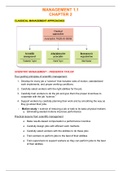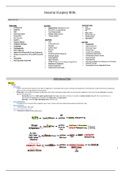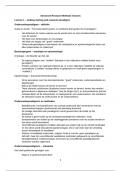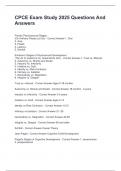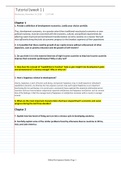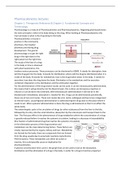Summary Resistance and
Persuasion
Lectures (notes), Literature, and Exam Questions
Lecture 1 – Introduction
Why Resistance and Persuasion?
- Boomerang effect
- “I’ll decide what I eat myself!”
- “I LOVE MEAT, F*CK OFF!”
- “Usually two slabs, now four! This way I compensate someone who
doesn’t eat meat today. And again tomorrow!”
Understanding resistance
Knowles & Linn, 2005; Fransen, 2023:
- “To understand and be successful at persuasion, you need to
understand resistance”
- “Resistance is the most important element in the persuasion
process”
Resistance: a definition
Depends on perspective
- A reaction against change: “I don’t like it”, “I don’t believe it”, “I
won’t do it”
o Behavior
o Cognition
o Affective
- The ability to withstand a persuasive attack
- An outcome: not being moved by pressures to change
- A motivational state: motivation to oppose and counter pressures
to change
,Lecture 2 – Resistance processes I:
Psychological reactance and politeness
theory
Psychological reactance
Wanting to do the opposite due to lack of sense of freedom
Reactance theory (Brehm, 1966)
1. Freedom: need to make own decisions autonomous
2. Threat to freedom: exercise freedom
3. Reactance: negative feelings/thoughts
4. Restoring freedom: re-establish
a. Direct: boomerang, rebell
b. Indirect: derogate source threat, increase forbidden choice,
denial threat, exercise different freedom
The nature of reactance
Dillard & Shen (2005) and Rains & Turner (2005):
- Purely cognitive: thought, counterarguing
- Purely affective: negative effect
- Cognitive and affective (distinct effects > dual-process)
- Cognitive and affective (linear effects)
- Cognitive and affective (intertwined effects) best
A Single Process Cognitive Model
Antecedents to Cognitive Attitude
reactance
A Single Process Affective Model
Antecedents to Anger Attitude
reactance
A Dual Process Cognitive-affective Model
Antecedents to Cognitive Attitude
reactance Anger
A Linear Process Affective-Cognitive Model
Antecedents to Anger Cognition Attitude
reactance
An Intertwined Process Cognitive-affective Model
Antecedents to Reactance Attitude
reactance Cognition Anger
reactance: latent variable
Using reactance to promote change
Persuasive strategy:
- Reverse psychology (children)
, - Scarcity (e.g. shoes)
Politeness theory (Brown & Levinson, 1987)
- People have a fundamental need for autonomy and independence
o Negative face wants (autonomy, independence)
- People have a fundamental need for approval, acceptance, and
being viewed as competent
o Positive face wants (liked, respected, polite)
Theory of language use
- Face-maintenance in conversations (polite vs. impolite)
o Chose words carefully
- Language has a meta-communicative value (perceived social
relationship)
- Resistance to persuasion is a defensive reaction to an unjustified
relational claim (threatening one or both aspects of face)
o Claim for power words
Persuasive messages as FTAs
- Containing forceful language:
o Using imperatives such as commands and orders
(controlling) commands
o Demeaning anyone who does not agree with the advocated
stance not agree advocate stance
- Forceful message is less likely to be viewed as a threat to face when:
o Source has greater/legitimate power relative to recipient
o Situation legitimizes coercion (requires maximum efficiency)
commands in emergency
Take home
Resistance to persuasion may be a motivational response resulting from a
threat to our autonomy
Lecture 3 – Resistance processes II:
Persuasion knowledge and advertising
literacy
E.g. Balenciaga ad:
- Avoidance
- Disapproval
- Negative cognitions
- Negative emotions
- Skepticism/suspicion
Persuasion knowledge
Persuasion
Lectures (notes), Literature, and Exam Questions
Lecture 1 – Introduction
Why Resistance and Persuasion?
- Boomerang effect
- “I’ll decide what I eat myself!”
- “I LOVE MEAT, F*CK OFF!”
- “Usually two slabs, now four! This way I compensate someone who
doesn’t eat meat today. And again tomorrow!”
Understanding resistance
Knowles & Linn, 2005; Fransen, 2023:
- “To understand and be successful at persuasion, you need to
understand resistance”
- “Resistance is the most important element in the persuasion
process”
Resistance: a definition
Depends on perspective
- A reaction against change: “I don’t like it”, “I don’t believe it”, “I
won’t do it”
o Behavior
o Cognition
o Affective
- The ability to withstand a persuasive attack
- An outcome: not being moved by pressures to change
- A motivational state: motivation to oppose and counter pressures
to change
,Lecture 2 – Resistance processes I:
Psychological reactance and politeness
theory
Psychological reactance
Wanting to do the opposite due to lack of sense of freedom
Reactance theory (Brehm, 1966)
1. Freedom: need to make own decisions autonomous
2. Threat to freedom: exercise freedom
3. Reactance: negative feelings/thoughts
4. Restoring freedom: re-establish
a. Direct: boomerang, rebell
b. Indirect: derogate source threat, increase forbidden choice,
denial threat, exercise different freedom
The nature of reactance
Dillard & Shen (2005) and Rains & Turner (2005):
- Purely cognitive: thought, counterarguing
- Purely affective: negative effect
- Cognitive and affective (distinct effects > dual-process)
- Cognitive and affective (linear effects)
- Cognitive and affective (intertwined effects) best
A Single Process Cognitive Model
Antecedents to Cognitive Attitude
reactance
A Single Process Affective Model
Antecedents to Anger Attitude
reactance
A Dual Process Cognitive-affective Model
Antecedents to Cognitive Attitude
reactance Anger
A Linear Process Affective-Cognitive Model
Antecedents to Anger Cognition Attitude
reactance
An Intertwined Process Cognitive-affective Model
Antecedents to Reactance Attitude
reactance Cognition Anger
reactance: latent variable
Using reactance to promote change
Persuasive strategy:
- Reverse psychology (children)
, - Scarcity (e.g. shoes)
Politeness theory (Brown & Levinson, 1987)
- People have a fundamental need for autonomy and independence
o Negative face wants (autonomy, independence)
- People have a fundamental need for approval, acceptance, and
being viewed as competent
o Positive face wants (liked, respected, polite)
Theory of language use
- Face-maintenance in conversations (polite vs. impolite)
o Chose words carefully
- Language has a meta-communicative value (perceived social
relationship)
- Resistance to persuasion is a defensive reaction to an unjustified
relational claim (threatening one or both aspects of face)
o Claim for power words
Persuasive messages as FTAs
- Containing forceful language:
o Using imperatives such as commands and orders
(controlling) commands
o Demeaning anyone who does not agree with the advocated
stance not agree advocate stance
- Forceful message is less likely to be viewed as a threat to face when:
o Source has greater/legitimate power relative to recipient
o Situation legitimizes coercion (requires maximum efficiency)
commands in emergency
Take home
Resistance to persuasion may be a motivational response resulting from a
threat to our autonomy
Lecture 3 – Resistance processes II:
Persuasion knowledge and advertising
literacy
E.g. Balenciaga ad:
- Avoidance
- Disapproval
- Negative cognitions
- Negative emotions
- Skepticism/suspicion
Persuasion knowledge

